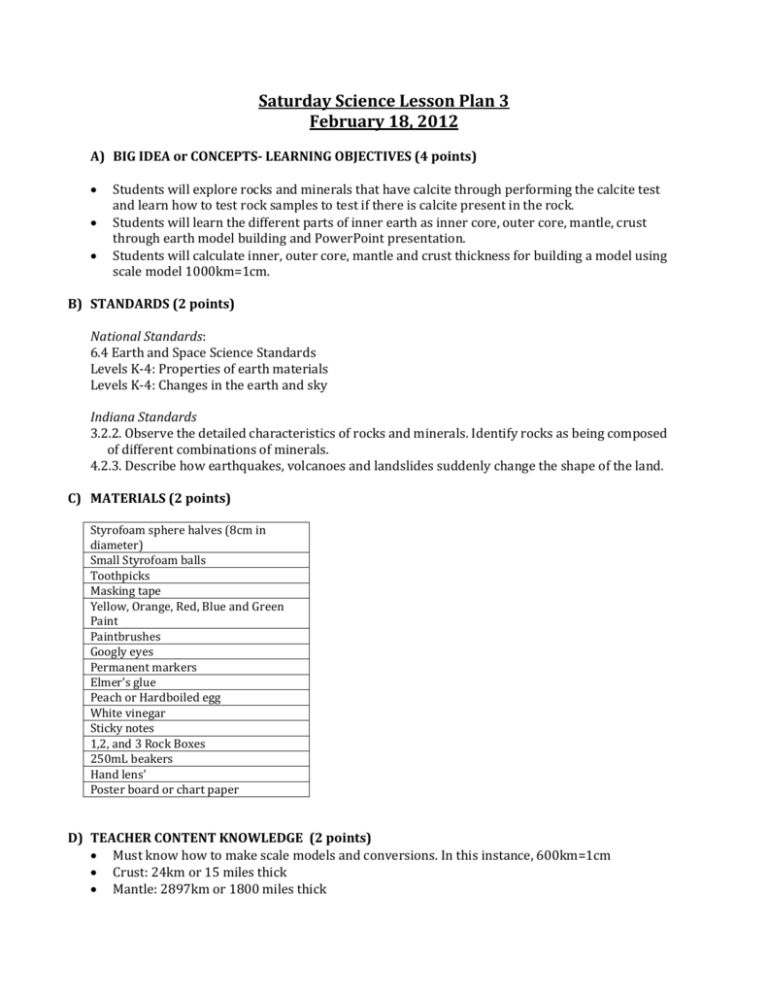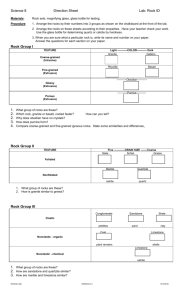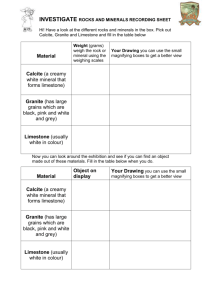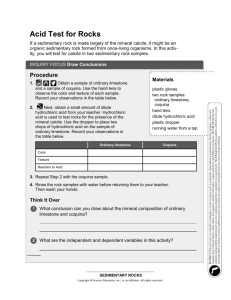Week 3 Lesson
advertisement

Saturday Science Lesson Plan 3 February 18, 2012 A) BIG IDEA or CONCEPTS- LEARNING OBJECTIVES (4 points) Students will explore rocks and minerals that have calcite through performing the calcite test and learn how to test rock samples to test if there is calcite present in the rock. Students will learn the different parts of inner earth as inner core, outer core, mantle, crust through earth model building and PowerPoint presentation. Students will calculate inner, outer core, mantle and crust thickness for building a model using scale model 1000km=1cm. B) STANDARDS (2 points) National Standards: 6.4 Earth and Space Science Standards Levels K-4: Properties of earth materials Levels K-4: Changes in the earth and sky Indiana Standards 3.2.2. Observe the detailed characteristics of rocks and minerals. Identify rocks as being composed of different combinations of minerals. 4.2.3. Describe how earthquakes, volcanoes and landslides suddenly change the shape of the land. C) MATERIALS (2 points) Styrofoam sphere halves (8cm in diameter) Small Styrofoam balls Toothpicks Masking tape Yellow, Orange, Red, Blue and Green Paint Paintbrushes Googly eyes Permanent markers Elmer’s glue Peach or Hardboiled egg White vinegar Sticky notes 1,2, and 3 Rock Boxes 250mL beakers Hand lens’ Poster board or chart paper D) TEACHER CONTENT KNOWLEDGE (2 points) Must know how to make scale models and conversions. In this instance, 600km=1cm Crust: 24km or 15 miles thick Mantle: 2897km or 1800 miles thick Outer Core: 2253km or 1400 miles thick Inner Core: 1287km or 800 miles thick graphic from http://www.science.org.au/nova/116/116box01.html Must understand the resemblance that a peach or an egg has to the earth to draw comparisons. Pit or yolk- core, fruit- mantle, skin or shell- crust Calcite reacts with the acetic acid found in vinegar. Do not confuse the bubbles given off by the reaction with bubbles displaced from air pockets in the rock. Bubbles from the reaction will be continuous and tiny and will form strings. While air pocket bubbles are bigger and not continuous. Calcite is common in limestone and marble. (pressure, temperature and time turns limestone into marble. Since the industrial revolution, acid rain has caused problems with buildings made of limestone and marble. They dissolve when the calcite in the rock reacts with the acid in the rain. E) REFERENCES & HANDOUTS (1 point) Calcite Test Handout KWL chart (on chart paper) Vocab PowerPoint F) DESCRIPTION OF YOUR LESSON (6 points) 9:00-9:30 Early bird engagement: students will have time to look over several books that are part of a text set about the earth that are set at each table until everyone arrives. 9:30-9:45 Complete mock rocks 9:45-10:25 Calcite Test 10:25- 10:45 Peach or Egg demonstration, KWL Chart and PowerPoint/Video 10:45- 11:00 Snack 11:00-11:15 Calculations for model earth 11:15-12:00 Planning, measuring and painting ENGAGE 1. Seat students where their folders are located after they sign in. 2. Students that arrive early will be instructed to look over the books at their table until class starts. 3. At 9:30 teacher will pass out the mock rocks from the last week. 4. Each student will be allowed to draw on a mouth, glue on googly eyes and put the finishing touches on their pet rocks. 5. Each student will then refer back to their Pet Rock planning sheet from the previous week and make a list inside of their journals of discrepancies between the rocks final look and their planning sheet. 6. Students will find out properties (or find similar looking properties) of igneous, sedimentary, and metamorphic rocks that can be observed in their pet rocks. 7. After reviewing the properties of rock identification from their pet rock handout (hardness, color, size, shape and texture) I will inform the class that there is one final test geologists do to classify rocks called the calcite test. EXPLORE 1. “Calcite is one of the most common minerals on earths surface. It has a property that no other mineral has. It reacts with cold acid. A geologist often carries a small bottle of hydrochloric acid to test rocks for calcite. Because hydrochloric acid is dangerous, we will test rocks for calcite with a less concentrated acid, vinegar.” 2. No other mineral reacts with cold acid this way so this property is a useful test for the presence of calcite in a rock. 3. The students will receive a tray. On each tray there will be a calcite test handout with the rocks basalt, limestone, calcite and marble in their respective places and 4 beakers. The beakers will each be filled about 2/3 of the way full of white vinegar. 4. We want to do this test to see if these rock samples contain calcite. So first we want to know what we’re looking for. We need to know what the calcite reaction looks like so we know what to look for in the other rock samples. 5. REMIND STUDENTS TO USE CARE WITH VINEGAR. AVOID SPILLS AND KEEP IT OFF CLOTHES AND OUT OF EYES. 6. When I say go, one person from each table drop the calcite sample into the vinegar. Everyone needs to write down their observations in the Calcite box on their handout. 7. At this point we will share observations and note the difference between the bubbles we saw and bubbles that might come out of an air pocket inside of a rock. 8. The students will be able to perform the test on the other 3 rock samples. 9. Students should be making observations in each of the 4 boxes on their handouts. I can assess the students on their ability to make detailed observation notes. If they write a description that clearly identifies each rock, they will get a passing assessment. 10. We will review as a class which rocks have calcite in them. Limestone, and marble do because with pressure, temperature and time turns limestone into marble. But basalt does not. EXPLAIN 1. Using an egg or peach I will draw comparisons between the structure of the inner earth to the structure of the food. 2. I will make a large KWL chart about the inner earth. 3. Students will receive 5 sticky notes. I will tell them that at least 3 of their notes must go up on the KWL chart before they can start their model activity. 4. PowerPoint explaining each of the parts of inner earth with many pictures. 5. Video http://www.youtube.com/watch?v=uMcNCbR7B40 EXPLORE Step 1: Find the center of sphere Diameter=8cm Step 2: Measure hole for core Carve hole for core Step 3: Convert km to cm…1000 km=1cm. Round up! Mark measurements on model (the more measurements you mark, the easier it will be to make a circle.) Step 4: Paint models Use yellow, orange, red and blue/green Step 5: Insert core Use tape and toothpicks to label all areas Use toothpicks to make a tripod stand for your sphere half Crust: 24km or 15 miles thick Mantle: 2897km or 1800 miles thick Outer Core: 2253km or 1400 miles thick Inner Core: 1287km or 800 miles thick Crust: .024 Mantle: 2.89=3cm Outer Core:1.4=2 Inner Core:.8=1 Explain As a class we will take time to look at the other models the class created. We will share hard parts and successes that the students had while making their models Finally we will review each layers name and a function by a discussion about the resemblance of earth layers and the hard boiled egg. ELABORATION 1. In their science journals ask the students to write: Two things that they learned today that they found especially interesting that they can teach the person that is coming to pick them up. At least one question they still have. Gear up- Give the students less guidance when doing calculations and measuring if they have everything under control during their model building. Once their models are complete, if they finish early I would suggest using other colors of paint (perhaps mixing paint to make original colors) to add texture to the respective layers. Students could also assist other teams with their calculations, because I expect this to be a challenge to most of the students. Gear down- Do the calculations as a class and give specific instruction for measuring, doing one layer at a time during the model building. Calcite Test Name:________________________________________________________ Basalt Limestone Marble Calcite




